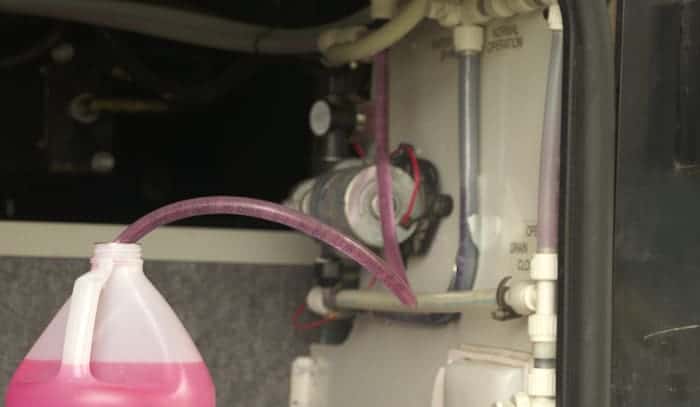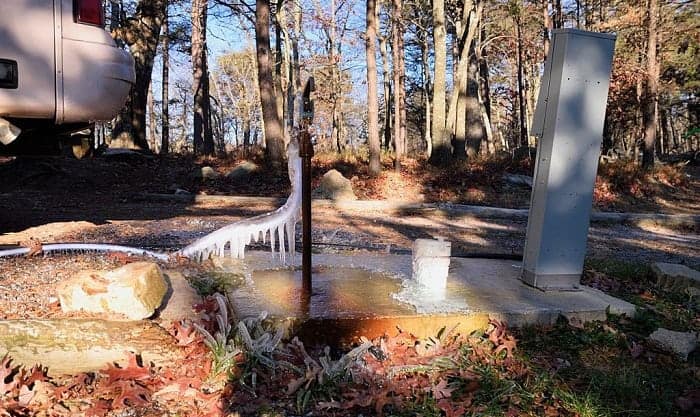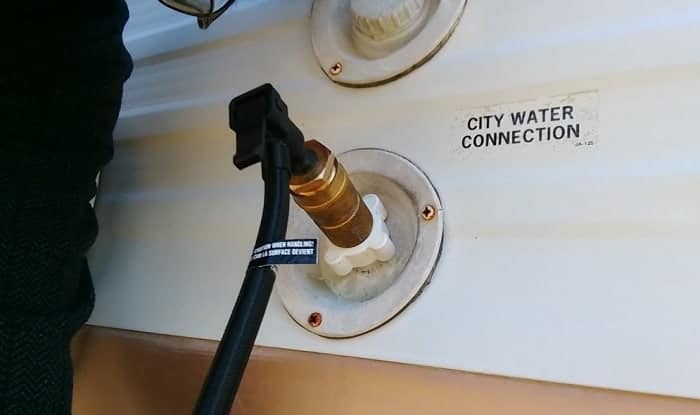Preparing your beloved motorhome for winters might not be your favorite job when the holiday season is approaching. Then again, would you like to spend a fortune in post-winter repairs? Or are you planning to head south this winter? We believe your answer is no. So, in this article about Blowing Out RV Water Lines vs. Antifreeze we are going to take you through a comparison between the two basic methods of winterizing your RV.
Table of Contents
Winterizing The RV
The main focus of winterizing the RV is the plumbing system. All holding tanks, water pipes, lines, and plumbing fixtures should be dried so that the water inside them does not freeze. Apart from these, all perishable food items, personal hygiene products, and cleaning supplies must be removed from the RV. Not only a thorough cleaning helps you get rid of the moisture that can cause freezing, but it will also save your RV from being infected by mice.
If the pipes, water lines, or tanks have water left, it can freeze due to winters and expand. The expansion of these fixtures can cause serious damage, which can be expensive to get fixed.
Blowing Out RV Water Lines vs. Antifreeze
The question is whether to use the Blowing Out method to clean the RV drainage or opt for Antifreeze. While the two methods work incredibly well for winterizing the RV, one might suit you more than the other.
Blowing out the RV water involves air pressure to get rid of every drop of water in the pipes with the help of an air compressor. It does sound like the most convenient method to dry out the RV’s plumbing and leave it dry for winters. Plus, the air is free!
We are afraid that blowing out is easy and fun only in theory, as there are major drawbacks. For starters, air will successfully push out most of the moisture from the pipes, but there is no guarantee that it will blow out all of it. The residual water can collect into a low spot in plumbing, freeze, and cause expansion of pipes. Ultimately, you will be forced to shell out for plumbing repairs.
Blowing out the water might be the perfect technique for smaller RVs with simple drainage, but it is not meant for more complex trucks. In such cases, the RV riders and dealers are more inclined towards Antifreeze.
Antifreeze is a solution that mixes with any moisture in the plumbing of the RV, preventing it from freezing. It is a non-toxic solution that does not ruin your freshwater systems. Its main job is to turn all the water into a slush that can rest into your RV throughout the winters. It can serve complex and simpler plumbing systems equally well. However, there are disadvantages to using Antifreeze as well.
While air used for blowing out is free, Antifreeze can discourage RV dealers as it requires you to invest in a few gallons every season. Plus, the water in RV may taste slightly bitter after winters because it had Antifreeze resting in the plumbing for months.
We do have a solution for all the bitterness, though. All you have to do is blow out the entire system once with the help of an air compressor. Now, use the main water supply to distribute Antifreeze in the plumbing. Make sure it reaches every nook and corner of the RV.
Once you have run antifreeze solution across the pipes and fixtures of the RV, use the air compressor once again. You can now blow out all the Antifreeze from the pipes so that they do not catch the smell and taste. Do not forget to collect the blown-out solution as most of it can be recaptured for the following year.
When you blow out all the Antifreeze within a couple of hours, you not only avoid the bitter taste, but you also make flushing out the Antifreeze easier for yourself once the winters are over.
How to Winterize The RV?
Now that you know the merits and demerits of the above methods, here is how you can perform the winterization following the two methods.
1. Blowing Out The System With Compressed Air
First, you need to use a good quality air compressor with a blow out plug attachment to blow all the water and moisture out of the plumbing. The EP Auto Portable Air Compressor is a great option for this.
a) Begin with disconnecting the rig from outside water supply and turn off the power in the rig. Deactivate the propane as well.
b) Since you do not want to drain out your water heater, you should bypass it. Most RVs allow you an option to bypass the heater by switching the valve. If yours doesn’t, then you can buy a cheap bypass kit from a hardware store.
c) The refrigerator, dishwasher, and washing machine in your RV might come with a preset winterization technique. So, before applying your efforts into winterizing them through the air, consult the owner’s manual. Often, they have separate instructions for preparing these devices for winters.
d) Now open all the faucets, taps, and showers that you have in your RV along with the system valves to let the air out. The valve locations can be found in the owner’s manual. Ensure that you have flushed the toilets beforehand to clean the water.
e) The next step would be to connect the blow out plug to the RV water inlet. Do not connect it with the freshwater tank. Also, make sure that the pressure of the compressor is below 30 psi to avoid damages.
f) Connect the compressor with the blow out plug and start running air through your plumbing. Make sure it goes everywhere evenly and keep going till you are sure that you have removed all the moisture. Now flush all the grey and black water in the RV and drain out all freshwater tanks.
g) In the end, shut all the valves carefully. You can use some anti-freeze solution for the grey and black water to ensure that the water in those tanks doesn’t freeze. It will help you protect the valves and seals from getting cracked sue to solidified liquid.
2. Using Antifreeze
If you are done blowing out the moisture from your RV’s plumbing with the help of an air compressor, you can follow up with some antifreeze. All you need is a couple of gallons of Antifreeze, and you are good to go. The Splash Pink 619526 is reviewed well by users. Just ensure that the solution doesn’t reach the fresh water tank; otherwise, your water will taste bitter in the coming spring.
Apart from the drainage and plumbing, you should focus on other areas such as tires, engines, batteries, stabilizing jacks, propane, interior, and more. If ignored, they can also burn a hole in your pocket.
Batteries
The batteries you are using should not be exposed to harsh winters. So, charge the batteries completely and then store them in a warm and dry place. If not that, disconnect the negative side first.
Engine
Topping off the fuel tanks will leave no room for condensation. Plus, you can add some fuel stabilizer in them and allow the engine to run idle for some time. This will help the stabilizer reach the vehicle’s interiors. Fill the radiator with the automotive Antifreeze.
Propane
Top off all your propane tanks and remove the external ones to be stored in a warmer place. Use rubber bands and plastic bags to cover all connections and fittings so that insects do not house on them.
Food and Drinks
No trace of edible material should be left in the RV over winter as it can attract insects and rodents. So, clean your RV thoroughly. Also, remove all the bedding, linen, and clothes as they can entice pests too.
Final Thoughts
Maintaining an RV can be challenging, especially when winters are approaching. Then again, it is important to protect your home on-the-go by following some basic guidelines.
- Use a combination of blowing out and Antifreeze to winterize your RV.
- Always ensure that Antifreeze bypasses the heater and freshwater tanks.
- Do not overlook the other parts of the RV, such as tires, propane tanks, batteries, engines, etc.
- Remove all the food, drinks, clothing, bedding, and linens from the RV as they can attract pests, insects, and rodents.

Hi, I am Tom Hank, an RV-er since 2014. Back then, I started without much help. As you can imagine, the struggles are endless. But now, you do not have to begin your adventures knowing next to nothing about RV lives.




